

Compact Muon Solenoid
LHC, CERN
| CMS-PAS-B2G-17-006 | ||
| Search for heavy resonances decaying into two Higgs bosons or into a Higgs and a vector boson in proton-proton collisions at 13 TeV | ||
| CMS Collaboration | ||
| December 2017 | ||
| Abstract: A search is presented for massive resonances decaying either into two Higgs (H) bosons or into a Higgs and a vector (V = W or Z) boson. The decay channels considered are $\mathrm{VH} \rightarrow q\bar{q}\tau^{+}\tau^{-}$ and $\mathrm{HH} \rightarrow b\bar{b}\tau^{+}\tau^{-}$. This analysis is based on the data sample of proton-proton collisions collected at a center-of-mass energy of 13 TeV by the CMS Collaboration in 2016, corresponding to an integrated luminosity of 35.9 fb$^{-1}$. For the high-mass resonances considered ($\geq $ 1 TeV), substructure techniques are employed to differentiate between the hadronization products of a vector boson decaying to quarks, a Higgs boson decaying to bottom quarks, and quark- or gluon-induced jets. Due to the large boost of the Higgs boson, the two leptons in the $H \rightarrow \tau^{+}\tau^{-}$ decay are collimated. Advanced techniques are used for events in which one $\tau$ lepton decays hadronically and the other leptonically, and in which both decay hadronically. Upper limits at 95% confidence level are set on the product of cross section times branching fraction for resonance masses between 900 and 4000 GeV, ranging from 100 to 6 fb for spin 0 and 2 resonances, and from 250 to 6 fb for spin 1 resonances. | ||
|
Links:
CDS record (PDF) ;
inSPIRE record ;
CADI line (restricted) ;
These preliminary results are superseded in this paper, JHEP 01 (2019) 051. The superseded preliminary plots can be found here. |
||
| Figures | |

png pdf |
Figure 1:
Feynman diagrams for the production of a heavy vector boson V' (W' or Z') that decays to a vector boson and a Higgs boson (left) and the production of a spin-0 radion or a spin-2 graviton that decays to a Higgs boson pair (right). |

png pdf |
Figure 1-a:
Feynman diagrams for the production of a heavy vector boson V' (W' or Z') that decays to a vector boson and a Higgs boson. |
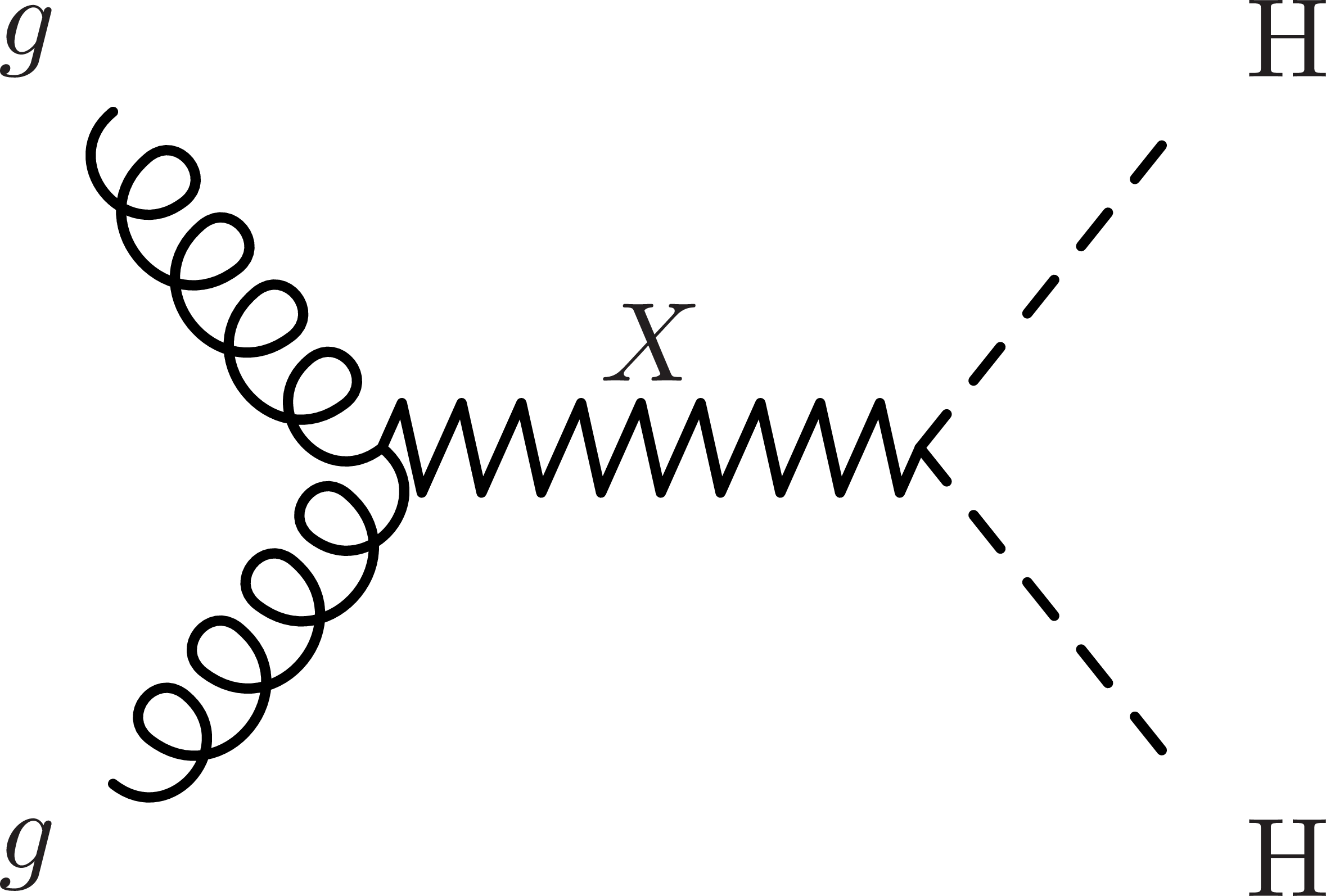
png pdf |
Figure 1-b:
Feynman diagrams for the production of a spin-0 radion or a spin-2 graviton that decays to a Higgs boson pair. |

png pdf |
Figure 2:
Fit to data for the $\tau _{21}$ HP $\ell \tau _{h}$ channel of the softdrop mass distribution in order to determine the background normalization (left) and to the resonance mass spectrum in order to determine the background shape in the sidebands (right). |

png pdf |
Figure 2-a:
Fit to data for the $\tau _{21}$ HP $\ell \tau _{h}$ channel of the softdrop mass distribution in order to determine the background normalization. |

png pdf |
Figure 2-b:
Fit to the resonance mass spectrum in order to determine the background shape in the sidebands. |
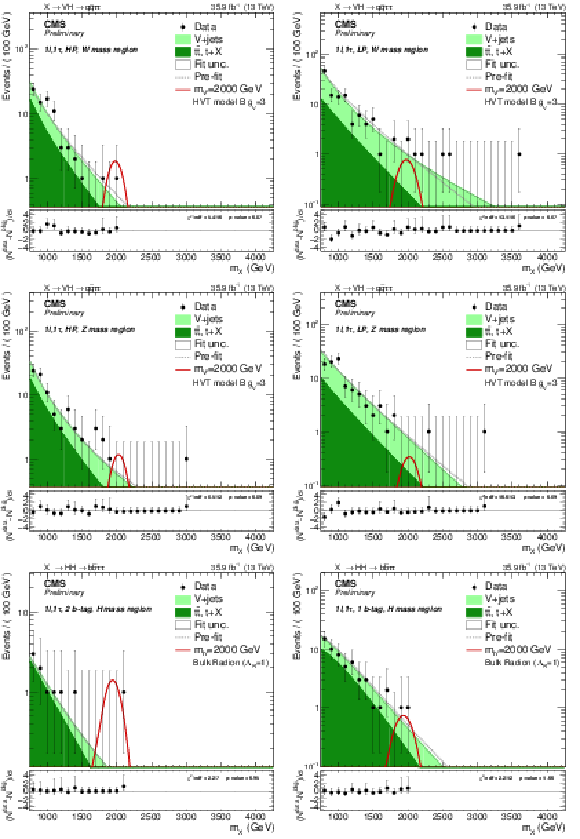
png pdf |
Figure 3:
Data and expected backgrounds determined with the $\alpha $ transfer function method in the $\ell \tau _{h}$ channel: W mass window for the $\tau _{21}$ HP (upper left) and LP (upper right) categories, Z mass window for the $\tau _{21}$ HP (middle left) and LP (middle right) categories, and H mass window for the 1 b tagged subjet (lower left) and 2 b tagged subjets (lower right) categories. Signal contributions are also shown assuming the benchmark scenario B of the HVT model for the V' and ${\lambda}_{R} =$ 1 for the radion, each with a mass of 2 TeV. |
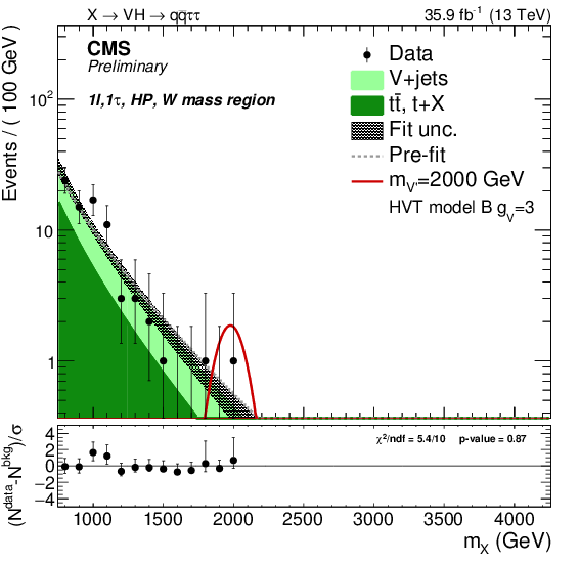
png pdf |
Figure 3-a:
Data and expected backgrounds determined with the $\alpha $ transfer function method in the $\ell \tau _{h}$ channel: W mass window for the $\tau _{21}$ HP category. Signal contributions are also shown assuming the benchmark scenario B of the HVT model for the V' and ${\lambda}_{R} =$ 1 for the radion, each with a mass of 2 TeV. |

png pdf |
Figure 3-b:
Data and expected backgrounds determined with the $\alpha $ transfer function method in the $\ell \tau _{h}$ channel: W mass window for the $\tau _{21}$ LP category. Signal contributions are also shown assuming the benchmark scenario B of the HVT model for the V' and ${\lambda}_{R} =$ 1 for the radion, each with a mass of 2 TeV. |

png pdf |
Figure 3-c:
Data and expected backgrounds determined with the $\alpha $ transfer function method in the $\ell \tau _{h}$ channel: Z mass window for the $\tau _{21}$ HP (middle right) category. Signal contributions are also shown assuming the benchmark scenario B of the HVT model for the V' and ${\lambda}_{R} =$ 1 for the radion, each with a mass of 2 TeV. |

png pdf |
Figure 3-d:
Data and expected backgrounds determined with the $\alpha $ transfer function method in the $\ell \tau _{h}$ channel: Z mass window for the $\tau _{21}$ LP (middle right) category. Signal contributions are also shown assuming the benchmark scenario B of the HVT model for the V' and ${\lambda}_{R} =$ 1 for the radion, each with a mass of 2 TeV. |

png pdf |
Figure 3-e:
Data and expected backgrounds determined with the $\alpha $ transfer function method in the $\ell \tau _{h}$ channel: H mass window for the 1 b tagged subjet category. Signal contributions are also shown assuming the benchmark scenario B of the HVT model for the V' and ${\lambda}_{R} =$ 1 for the radion, each with a mass of 2 TeV. |

png pdf |
Figure 3-f:
Data and expected backgrounds determined with the $\alpha $ transfer function method in the $\ell \tau _{h}$ channel: H mass window for the 2 b tagged subjets category. Signal contributions are also shown assuming the benchmark scenario B of the HVT model for the V' and ${\lambda}_{R} =$ 1 for the radion, each with a mass of 2 TeV. |

png pdf |
Figure 4:
Data and expected background determined with the $\alpha $ transfer function method in the $\tau _{h}\tau _{h}$ channel: W mass window for the $\tau _{21}$ HP (upper left) and LP (upper right) categories, Z mass window for the $\tau _{21}$ HP (middle left) and LP (middle right) categories, and H mass window for the 1 b-tagged subjet (lower left) and 2 b-tagged subjets (lower right) categories. Signal contributions are also shown assuming the benchmark scenario B of the HVT model for the V' and ${\lambda}_{R} = $ 1 for the radion, each with a mass of 2 TeV. |
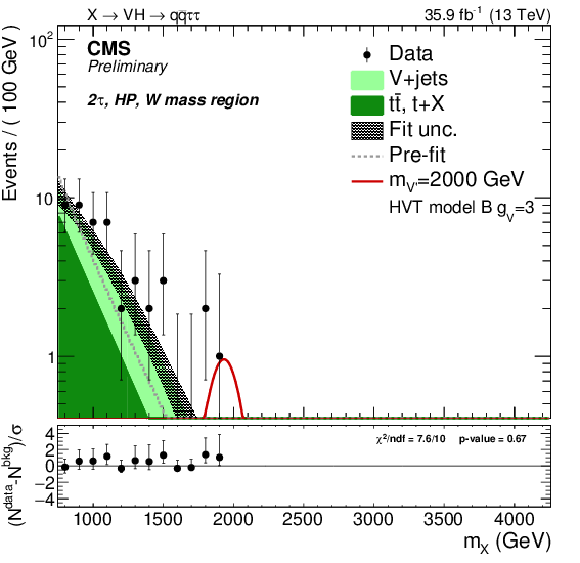
png pdf |
Figure 4-a:
Data and expected background determined with the $\alpha $ transfer function method in the $\tau _{h}\tau _{h}$ channel: W mass window for the $\tau _{21}$ HP category. Signal contributions are also shown assuming the benchmark scenario B of the HVT model for the V' and ${\lambda}_{R} = $ 1 for the radion, each with a mass of 2 TeV. |

png pdf |
Figure 4-b:
Data and expected background determined with the $\alpha $ transfer function method in the $\tau _{h}\tau _{h}$ channel: W mass window for the $\tau _{21}$ LP category. Signal contributions are also shown assuming the benchmark scenario B of the HVT model for the V' and ${\lambda}_{R} = $ 1 for the radion, each with a mass of 2 TeV. |

png pdf |
Figure 4-c:
Data and expected background determined with the $\alpha $ transfer function method in the $\tau _{h}\tau _{h}$ channel: Z mass window for the $\tau _{21}$ HP category. Signal contributions are also shown assuming the benchmark scenario B of the HVT model for the V' and ${\lambda}_{R} = $ 1 for the radion, each with a mass of 2 TeV. |

png pdf |
Figure 4-d:
Data and expected background determined with the $\alpha $ transfer function method in the $\tau _{h}\tau _{h}$ channel: Z mass window for the $\tau _{21}$ LP category. Signal contributions are also shown assuming the benchmark scenario B of the HVT model for the V' and ${\lambda}_{R} = $ 1 for the radion, each with a mass of 2 TeV. |

png pdf |
Figure 4-e:
Data and expected background determined with the $\alpha $ transfer function method in the $\tau _{h}\tau _{h}$ channel: H mass window for the 1 b-tagged subjet category. Signal contributions are also shown assuming the benchmark scenario B of the HVT model for the V' and ${\lambda}_{R} = $ 1 for the radion, each with a mass of 2 TeV. |

png pdf |
Figure 4-f:
Data and expected background determined with the $\alpha $ transfer function method in the $\tau _{h}\tau _{h}$ channel: H mass window for the 2 b-tagged subjets category. Signal contributions are also shown assuming the benchmark scenario B of the HVT model for the V' and ${\lambda}_{R} = $ 1 for the radion, each with a mass of 2 TeV. |

png pdf |
Figure 5:
Observed 95% CL upper limits on $\sigma \times $BR(X$\rightarrow $WH) (left) and $\sigma \times $BR(Z$\rightarrow $ZH) (right). Expected limits are shown with 1 and 2$\sigma $ uncertainty bands. The $\ell \tau _{h}$ and $\tau _{h}\tau _{h}$ final states, HP and LP $\tau _{21}$ categories, and W and Z mass signal regions are combined. |
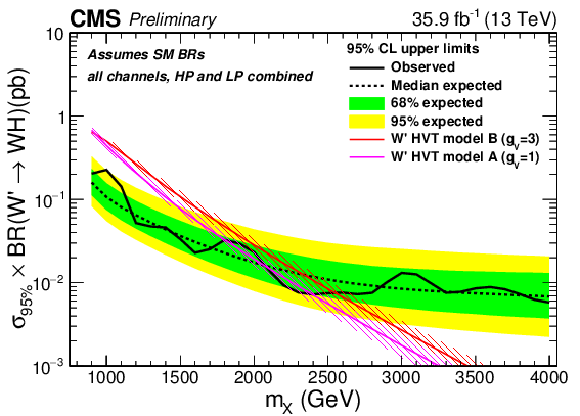
png pdf |
Figure 5-a:
Observed 95% CL upper limits on $\sigma \times $BR(X$\rightarrow $WH). Expected limits are shown with 1 and 2$\sigma $ uncertainty bands. The $\ell \tau _{h}$ and $\tau _{h}\tau _{h}$ final states, HP and LP $\tau _{21}$ categories, and W and Z mass signal regions are combined. |

png pdf |
Figure 5-b:
Observed 95% CL upper limits on $\sigma \times $BR(Z$\rightarrow $ZH). Expected limits are shown with 1 and 2$\sigma $ uncertainty bands. The $\ell \tau _{h}$ and $\tau _{h}\tau _{h}$ final states, HP and LP $\tau _{21}$ categories, and W and Z mass signal regions are combined. |

png pdf |
Figure 6:
Observed 95% CL upper limits on $\sigma \times $BR(X(spin-0)$\rightarrow $HH) (left) and $\sigma \times $BR(X(spin-2)$\rightarrow $HH) (right). Expected limits are shown with 1 and 2$\sigma $ uncertainty bands. The $\ell \tau _{h}$ and $\tau _{h}\tau _{h}$ final states, and 1 and 2 sub-jet b-tag categories are combined. |

png pdf |
Figure 6-a:
Observed 95% CL upper limits on $\sigma \times $BR(X(spin-0)$\rightarrow $HH). Expected limits are shown with 1 and 2$\sigma $ uncertainty bands. The $\ell \tau _{h}$ and $\tau _{h}\tau _{h}$ final states, and 1 and 2 sub-jet b-tag categories are combined. |

png pdf |
Figure 6-b:
Observed 95% CL upper limits on $\sigma \times $BR(X(spin-2)$\rightarrow $HH). Expected limits are shown with 1 and 2$\sigma $ uncertainty bands. The $\ell \tau _{h}$ and $\tau _{h}\tau _{h}$ final states, and 1 and 2 sub-jet b-tag categories are combined. |

png pdf |
Figure 7:
Expected (with $ \pm 1 (2) \sigma $ bands) and observed 95% CL upper limit on $\sigma \times $BR(X$\rightarrow $VH) (left) in the $\ell \tau _{h}$ and $\tau _{h}\tau _{h}$, $\tau _{21}$ HP and LP categories, with W and Z mass signal regions combined. Observed exclusion limit (right) in the space of the HVT model parameters $[ g_{V} c_{H}, g^2 c_{F}/g_{V}]$, described in the text, for three different mass hypotheses (1.5, 2, and 3 TeV). The region of parameter space where the natural resonance width is larger than the typical experimental resolution of 7%, for which the narrow width assumption is not valid, is shaded in grey. |

png pdf |
Figure 7-a:
Expected (with $ \pm 1 (2) \sigma $ bands) and observed 95% CL upper limit on $\sigma \times $BR(X$\rightarrow $VH) in the $\ell \tau _{h}$ and $\tau _{h}\tau _{h}$, $\tau _{21}$ HP and LP categories, with W and Z mass signal regions combined. |

png pdf |
Figure 7-b :
Observed exclusion limit in the space of the HVT model parameters $[ g_{V} c_{H}, g^2 c_{F}/g_{V}]$, described in the text, for three different mass hypotheses (1.5, 2, and 3 TeV). The region of parameter space where the natural resonance width is larger than the typical experimental resolution of 7%, for which the narrow width assumption is not valid, is shaded in grey. |
| Tables | |

png pdf |
Table 1:
Normalization scale factors for top quark production for different event categories. Uncertainties are due to the limited size of data statistics in the control regions and the uncertainty on the b tagging efficiency. |

png pdf |
Table 2:
Predicted number of background events and observed number of events in the signal region, for all event categories. W, Z and H regions are intervals in the jet softdrop mass distribution that range from 65 GeV to 85 GeV, from 85 GeV to 105 GeV, and from 105 GeV to 135 GeV respectively. Separate sources of uncertainty in the expected number are reported: the statistical uncertainty on the V+jet contribution from the fit procedure (fit), the one due to the difference between the nominal and alternative function chosen for the fit (alt), and the top background uncertainty from the fit to the simulated jet mass spectrum. |

png pdf |
Table 3:
Summary of systematic uncertainties for the background and signal samples. Uncertainties marked with $\dagger $ are not included in the limit bands, but instead reported in the theory band. |
| Summary |
| A search has been conducted for heavy resonances, with masses between 900 GeV and 4 TeV, and which couple more strongly to bosons than fermions. The heavy particle is searched for in final states with two bosons: one of which is a W, Z, or H boson that decays hadronically; while the other is a Higgs boson that decays to a pair of tau leptons. The analyzed data are collected by the CMS experiment at $\sqrt{s}= $ 13 TeV during 2016 operations, corresponding to an integrated luminosity of 35.9 fb$^{-1}$. Depending on the resonance mass, expected upper limits on the production cross section times branching ratios to WH, ZH, and HH, for spin-1, spin-0, and spin-2 resonances are set between 250 and 6 fb. |
| References | ||||
| 1 | W. D. Goldberger and M. B. Wise | Modulus stabilization with bulk fields | PRL 83 (1999) 4922 | hep-ph/9907447 |
| 2 | O. DeWolfe, D. Z. Freedman, S. S. Gubser, and A. Karch | Modeling the fifth-dimension with scalars and gravity | PRD 62 (2000) 046008 | hep-th/9909134 |
| 3 | C. Csaki, M. Graesser, L. Randall, and J. Terning | Cosmology of brane models with radion stabilization | PRD 62 (2000) 045015 | hep-ph/9911406 |
| 4 | L. Randall and R. Sundrum | A large mass hierarchy from a small extra dimension | PRL 83 (1999) 3370 | hep-ph/9905221 |
| 5 | L. Randall and R. Sundrum | An alternative to compactification | PRL 83 (1999) 4690 | hep-th/9906064 |
| 6 | K. Agashe, H. Davoudiasl, G. Perez, and A. Soni | Warped Gravitons at the LHC and Beyond | PRD 76 (2007) 036006 | hep-ph/0701186 |
| 7 | A. L. Fitzpatrick, J. Kaplan, L. Randall, and L.-T. Wang | Searching for the Kaluza-Klein Graviton in Bulk RS Models | JHEP 09 (2007) 013 | hep-ph/0701150 |
| 8 | O. Antipin, D. Atwood, and A. Soni | Search for RS gravitons via W$ _L $ W$ _L $ decays | PLB 666 (2008) 155 | 0711.3175 |
| 9 | B. Bellazzini, C. Cs\'aki, and J. Serra | Composite Higgses | EPJC 74 (2014) 2766 | 1401.2457 |
| 10 | R. Contino, D. Marzocca, D. Pappadopulo, and R. Rattazzi | On the effect of resonances in composite Higgs phenomenology | JHEP 10 (2011) 081 | 1109.1570 |
| 11 | D. Marzocca, M. Serone, and J. Shu | General composite Higgs models | JHEP 08 (2012) 013 | 1205.0770 |
| 12 | D. Greco and D. Liu | Hunting composite vector resonances at the LHC: naturalness facing data | JHEP 12 (2014) 126 | 1410.2883 |
| 13 | M. Schmaltz and D. Tucker-Smith | Little Higgs review | Ann. Rev. Nucl. Part. Sci. 55 (2005) 229 | hep-ph/0502182 |
| 14 | N. Arkani-Hamed, A. Cohen, E. Katz, and A. Nelson | The Littlest Higgs | JHEP 07 (2002) 034 | hep-ph/0206021 |
| 15 | G. Altarelli, B. Mele, and M. Ruiz-Altaba | Searching for new heavy vector bosons in $ \rm p\bar{p} $ colliders | Z. Phys. C 45 (1989) 109 | |
| 16 | D. Pappadopulo, A. Thamm, R. Torre, and A. Wulzer | Heavy Vector Triplets: Bridging Theory and Data | JHEP 09 (2014) 060 | 1402.4431 |
| 17 | M. Gouzevitch et al. | Scale-invariant resonance tagging in multijet events and new physics in Higgs pair production | JHEP 07 (2013) 148 | 1303.6636 |
| 18 | ATLAS Collaboration | Search for new resonances decaying to a $ W $ or $ Z $ boson and a Higgs boson in the $ \ell^+ \ell^- b\bar b $, $ \ell \nu b\bar b $, and $ \nu\bar{\nu} b\bar b $ channels with $ pp $ collisions at $ \sqrt s = $ 13 TeV with the ATLAS detector | PLB 765 (2017) 32 | 1607.05621 |
| 19 | ATLAS Collaboration | Searches for heavy diboson resonances in pp collisions at $ \sqrt{s}= $ 13 TeV with the ATLAS detector | JHEP 09 (2016) 173 | 1606.04833 |
| 20 | CMS Collaboration | Search for new resonances decaying via WZ to leptons in proton-proton collisions at $ \sqrt s = $ 8 TeV | PLB 740 (2015) 83 | CMS-EXO-12-025 1407.3476 |
| 21 | CMS Collaboration | Search for massive resonances decaying into pairs of boosted bosons in semi-leptonic final states at $ \sqrt{s} = $ 8 TeV | JHEP 08 (2014) 174 | CMS-EXO-13-009 1405.3447 |
| 22 | CMS Collaboration | Search for massive resonances in dijet systems containing jets tagged as W or Z boson decays in pp collisions at $ \sqrt{s} = $ 8 TeV | JHEP 08 (2014) 173 | CMS-EXO-12-024 1405.1994 |
| 23 | CMS Collaboration | Search for massive WH resonances decaying into the $ \ell \nu \mathrm{b} \overline{\mathrm{b}} $ final state at $ \sqrt{s}= $ 8 TeV | EPJC 76 (2016) 237 | CMS-EXO-14-010 1601.06431 |
| 24 | CMS Collaboration | Search for a massive resonance decaying into a Higgs boson and a W or Z boson in hadronic final states in proton-proton collisions at $ \sqrt{s}= $ 8 TeV | JHEP 02 (2016) 145 | CMS-EXO-14-009 1506.01443 |
| 25 | CMS Collaboration | Search for Narrow High-Mass Resonances in Proton-Proton Collisions at $ \sqrt{s} = $ 8 TeV Decaying to a Z and a Higgs Boson | PLB 748 (2015) 255 | CMS-EXO-13-007 1502.04994 |
| 26 | ATLAS Collaboration | Search for high-mass diboson resonances with boson-tagged jets in proton-proton collisions at $ \sqrt{s}= $ 8 TeV with the ATLAS detector | JHEP 12 (2015) 055 | 1506.00962 |
| 27 | ATLAS Collaboration | Search for production of WW/WZ resonances decaying to a lepton, neutrino and jets in pp collisions at $ \sqrt{s}= $ 8 TeV with the ATLAS detector | EPJC 75 (2015) 209 | 1503.04677 |
| 28 | ATLAS Collaboration | Search for WZ resonances in the fully leptonic channel using pp collisions at $ \sqrt{s} = $ 8 TeV with the ATLAS detector | PLB 737 (2014) 223 | 1406.4456 |
| 29 | ATLAS Collaboration | Search for a new resonance decaying to a W or Z boson and a Higgs boson in the $ \ell \ell / \ell \nu / \nu \nu + b \bar{b} $ final states with the ATLAS detector | EPJC 75 (2015) 263 | 1503.08089 |
| 30 | F. Dias et al. | Combination of Run-1 Exotic Searches in Diboson Final States at the LHC | JHEP 04 (2016) | 1512.03371 |
| 31 | CMS Collaboration | The CMS trigger system | JINST 12 (2017) P01020 | CMS-TRG-12-001 1609.02366 |
| 32 | CMS Collaboration | The CMS experiment at the CERN LHC | JINST 3 (2008) S08004 | CMS-00-001 |
| 33 | J. Alwall et al. | MadGraph 5 : Going Beyond | JHEP 06 (2011) 128 | 1106.0522 |
| 34 | P. Nason | A new method for combining NLO QCD with shower Monte Carlo algorithms | JHEP 11 (2004) 040 | hep-ph/0409146 |
| 35 | S. Frixione, P. Nason, and C. Oleari | Matching NLO QCD computations with Parton Shower simulations: the POWHEG method | JHEP 11 (2007) 070 | 0709.2092 |
| 36 | S. Alioli, P. Nason, C. Oleari, and E. Re | A general framework for implementing NLO calculations in shower Monte Carlo programs: the POWHEG BOX | JHEP 06 (2010) 043 | 1002.2581 |
| 37 | S. Alioli, S.-O. Moch, and P. Uwer | Hadronic top-quark pair-production with one jet and parton showering | JHEP 01 (2012) 137 | 1110.5251 |
| 38 | T. Sjostrand, S. Mrenna, and P. Z. Skands | PYTHIA 6.4 Physics and Manual | JHEP 05 (2006) 026 | hep-ph/0603175 |
| 39 | S. Jadach, J. H. Kuhn, and Z. Was | TAUOLA: A Library of Monte Carlo programs to simulate decays of polarized tau leptons | CPC 64 (1990) 275 | |
| 40 | GEANT4 Collaboration | GEANT4: A simulation toolkit | NIMA 506 (2003) 250 | |
| 41 | CMS Collaboration | Particle-flow reconstruction and global event description with the CMS detector | JINST 12 (2017), no. 10, P10003 | CMS-PRF-14-001 1706.04965 |
| 42 | M. Cacciari, G. P. Salam, and G. Soyez | The Anti-k(t) jet clustering algorithm | JHEP 04 (2008) 063 | 0802.1189 |
| 43 | M. Cacciari, G. P. Salam, and G. Soyez | FastJet User Manual | EPJC 72 (2012) 1896 | 1111.6097 |
| 44 | D. Bertolini, P. Harris, M. Low, and N. Tran | Pileup Per Particle Identification | JHEP 10 (2014) 059 | 1407.6013 |
| 45 | M. Dasgupta, A. Fregoso, S. Marzani, and G. P. Salam | Towards an understanding of jet substructure | JHEP 09 (2013) 029 | 1307.0007 |
| 46 | A. J. Larkoski, S. Marzani, G. Soyez, and J. Thaler | Soft drop | JHEP 05 (2014) 146 | 1402.2657 |
| 47 | J. Thaler and K. Van Tilburg | Identifying Boosted Objects with N-subjettiness | JHEP 03 (2011) 015 | 1011.2268 |
| 48 | CMS Collaboration | Jet algorithms performance in 13 TeV data | CMS-PAS-JME-16-003 | CMS-PAS-JME-16-003 |
| 49 | CMS Collaboration | Identification of b-quark jets with the CMS experiment | JINST 8 (2013) P04013 | CMS-BTV-12-001 1211.4462 |
| 50 | CMS Collaboration | Identification of b quark jets at the CMS Experiment in the LHC Run 2 | CMS-PAS-BTV-15-001 | CMS-PAS-BTV-15-001 |
| 51 | CMS Collaboration | Tau identification in boosted topologies | CDS | |
| 52 | M. Wobisch and T. Wengler | Hadronization corrections to jet cross-sections in deep inelastic scattering | in Monte Carlo generators for HERA physics. Proceedings, Workshop, Hamburg, Germany, 1998-1999, p. 270 1998 | hep-ph/9907280 |
| 53 | CMS Collaboration | Performance of tau-lepton reconstruction and identification in CMS | JINST 7 (2012) P01001 | CMS-TAU-11-001 1109.6034 |
| 54 | CMS Collaboration | Performance of electron reconstruction and selection with the CMS detector in proton-proton collisions at $ \sqrt{s} = $ 8 TeV | JINST 10 (2015) P06005 | CMS-EGM-13-001 1502.02701 |
| 55 | CMS Collaboration | Performance of CMS muon reconstruction in $ pp $ collision events at $ \sqrt{s} = $ 7 TeV | JINST 7 (2012) P10002 | CMS-MUO-10-004 1206.4071 |
| 56 | CMS Collaboration | Search for Neutral MSSM Higgs Bosons Decaying to Tau Pairs in $ pp $ Collisions at $ \sqrt{s}= $ 7 TeV | PRL 106 (2011) 231801 | CMS-HIG-10-002 1104.1619 |
| 57 | M. Bahr et al. | Herwig++ Physics and Manual | EPJC 58 (2008) 639 | 0803.0883 |
| 58 | A. L. Read | Presentation of search results: the $ CL_s $ technique | JPG 28 (2002) 2693 | |
| 59 | G. Cowan, K. Cranmer, E. Gross, and O. Vitells | Asymptotic formulae for likelihood-based tests of new physics | EPJC 71 (2011) 1554 | 1007.1727 |
| 60 | T. Junk | Confidence level computation for combining searches with small statistics | NIMA 434 (1999) 435 | hep-ex/9902006 |
| 61 | ATLAS and CMS Collaborations, LHC Higgs Combination Group | Procedure for the LHC Higgs boson search combination in Summer 2011 | CMS-NOTE-2011-005 | |

|
Compact Muon Solenoid LHC, CERN |

|

|

|

|

|

|